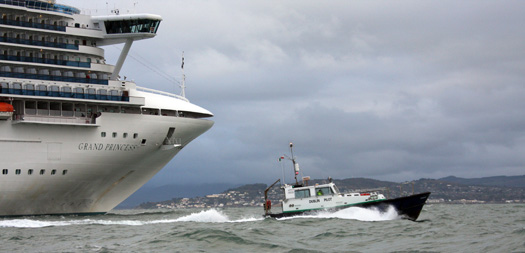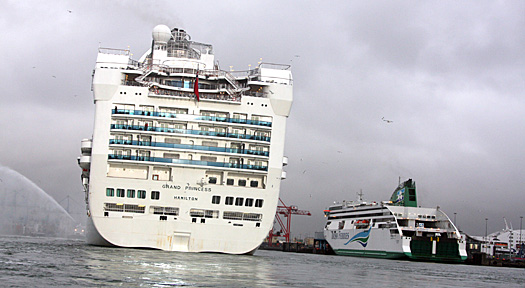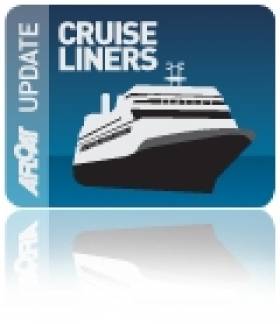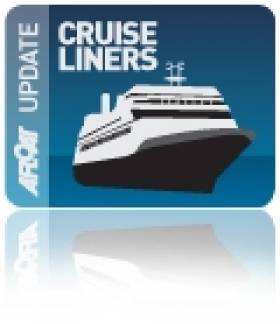Displaying items by tag: cruiseliner
Massive Cruise Liner Arrival Marks New Season for Dublin
#CRUISE–LINERS – The arrival of the €350 million Grand Princess cruise ship marked the opening of the 2012 Cruise season on Dublin Bay early this morning (Wed) when the 290 metre long vessel arrived overnight from Scotland on her only trip to Dublin this Summer.
The ship docked in Dublin Port is alongside for one night only and carries almost 4,000 high spend passengers and over 1,000 crew members.
During the winter the ship underwent an overhaul including the removal of part of her superstructure to save weight as Afloat previously reported here.
This year 90 cruise liners, 100,000 passengers contributing €35- €50m to the Dublin economy in 2012 will arrive into Dublin Bay. See the full list of Cruise calls to Dublin here.
The ship is the latest in cruise luxury with over 710 staterooms, an on-board shopping mall, cinema, a range of restaurant facilities, casino, swimming pools and a nine hole golf putting course.
The cruise sector has become a hugely important part of the city's tourism product since Dublin Port Company first targeted this trade in the mid 1990s.

A Dublin Port Pilot vessel escorts the Grand Princess into Dublin Bay
The Port Company estimates that cruise liners have contributed over €350 million to the city in the last decade.
The Port Company first targeted this trade in the mid 1990s. It is estimated that cruise liners have contributed over €350 million to the city in the last decade alone so Dublin Port Company is pleased to have played its role in attracting this business for the city.
Dublin Port Company recently announced it will invest €110m over the next five years implementing projects under its Masterplan 2012-2040 for future development at Dublin Port. Among the major projects identified in the Masterplan is the construction of a new cruise facility adjacent to the east of the East Link Bridge to accommodate the growing number of passengers and cruise ships coming to Dublin each season, bringing high spending passengers and crew within easy reach of the Luas, city centre shops, eateries and attractions.

The Grand Princess passes Poolbeg light on her way up the river Liffey and into Dublin city
To progress the project, Dublin Port Company has formed Cruise Dublin, a joint initiative with Dublin City Council and Dublin Chamber of Commerce aimed at further developing the cruise tourism trade in Dublin. A study of the needs of the cruise industry and best practice elsewhere on how a suitable cruise terminal can be provided in Dublin is currently underway. The estimated cost of the development is €30 million. This study will be concluded later this month with a view to having a cruise terminal in place by 2015.

The 290 metre long cruise liner arrives at her berth dwarfing the Irish Ferries ship Ulysses
Mr. Eamonn O'Reilly, Chief Executive, Dublin Port Company said, "Dublin Port is already the largest gateway for cruise visitors to Ireland and with 1.7 million ferry passengers moving through the port, is behind only Dublin Airport and Cork Airport as a national tourism hub. We have a fantastic offering here with a growing reputation internationally as the go-to city for high end cruise calls. Our location at the heart of Dublin beside the city's shops, restaurants and bars, as well as proximity to the airport make Dublin Port a very attractive destination for major cruise liner operators. We're delighted to have secured 90 cruises for 2012 and with our new joint initiative, Cruise Dublin, committed to increasing this valuable trade for Dublin in the best way possible."
Meanwhile a new dock in the south of the bay has been installed at the Coal quay in Dun Laoghaire harbour ready for next week's first cruise ship arrival into Dun Laoghaire.
Read more about Cruise liners and cruise liner visits to Ireland
Grand Princess is the first of the grand cruise liners that will form part of the 85 cruise visits that Dublin Port Company has secured for Dublin following its marketing efforts to attract this valuable business. The arrival of these ships will generate a major boost to the city of up to €50 million for the local economy, as the liners will carry almost 130,000 high-spend passengers to the capital this year along with significant numbers of crew who can experience the city during their shore leave.
The Grand Princess is 290 metres long, the equivalent in length of three football pitches and carries almost 3,000 high spend passengers and over 1,000 crew members. The $450 million vessel offers the latest in cruise luxury with over 710 staterooms, on-board shopping mall, cinema, a range of restaurant facilities, casino, swimming pools and even a nine hole golf putting course.
The cruise sector has become a hugely important part of the city's tourism product since Dublin Port Company first targeted this trade in the mid 1990s. It is estimated that cruise liners have contributed over €350 million to the city in the last decade alone so Dublin Port Company is pleased to have played its role in attracting this business for the city.
Mr. Eamonn O'Reilly, Chief Executive, Dublin Port Company said, "Dublin is a great city and a really fantastic destination for visitors. Having the port so close to the centre of Dublin makes it an attractive destination for cruise liner operators who can bring their passengers right to the heart Dublin allowing them to get to its visitor attractions as quickly as possible. We're delighted that Dublin Port Company can play such a major role in bringing this very valuable trade to Dublin."
Ms. Gina Quin, Chief Executive, Dublin Chamber of Commerce said; "The cruise industry has emerged as a significant contributor to the capital's tourism business. Dublin Port Company's ongoing work in attracting the cruise liners to the city provides a welcome boost of up to €50 million annually to Dublin's retailers and other businesses in the city. The 130,000 passengers and crew will no doubt experience the legendary Irish welcome as they visit the city's fabulous tourist attractions as well as the capital's bars and restaurants."






























































